Nutrition > EXAM > SCI 228 Final Exam (100 OUT OF 100) Questions and Answer solutions | DeVry University (All)
SCI 228 Final Exam (100 OUT OF 100) Questions and Answer solutions | DeVry University
Document Content and Description Below
SCI 228 Final Exam (TCO 1) The second step of the scientific method is: observation and description of a phenomenon. testing a research question or hypothesis. generating a hypothes... is. collecting data. (TCO 1) Which of the following is TRUE regarding the science of nutrition? As compared to many other scientific disciplines, nutrition is a young science. Discoveries by the first nutritional scientists established the connection between deficiencies and illness. In developed countries, current research in nutrition focuses on the relationship between diet and chronic diseases. All of these are true. (TCO 1) The type of study that observes a large population to determine factors that may influence nutritional habits and disease trends is called a (n): case-controlled study clinical trial epidemiological study animal study (TCO 1) Which of the following is NOT an essential nutrient? Water Alcohol Vitamins Minerals (TCO 2) Which of the following is associated with diets high in added sugars? Hyperactivity Tooth decay Diabetes All of these (TCO 2) The type of study that observes a large population to determine factors that may influence nutritional habits and disease trends is called a (n): case-controlled study. clinical trial. epidemiological study. animal study. (TCO 2) Which of the following is associated with the development of ketosis? A diet that contains too much fat A diet that contains insufficient fat A diet that contains too much carbohydrates A diet that contains insufficient carbohydrates (TCO 3) If a person is suffering from GERD, the is malfunctioning. gallbladder pancreas epiglottis gastro-esophageal sphincter (TCO 3) What is the primary cause of peptic ulcers? Stress H. pylori bacteria Prolonged use of aspirin Eating too many spicy foods (TCO 3) Which of the following would be an appropriate treatment approach for someone suffering from GERD? Surgical removal of the gallbladder Omission of all lactose foods Antibiotic therapy Loses weight and quits smoking (TCO 4) The simplest units of carbohydrates are called: fatty acids. amino acids. monosaccharides. calories. (TCO 4) is a highly branched arrangement of glucose molecules found in liver and skeletal muscle cells. Fructose Starch Glycogen Raffinose (TCO 4) Which of the following carbohydrates is the end product of photosynthesis? Glycogen Galactose Lactose Glucose (TCO 5) What are the three classes of lipids? Monosaccharide, disaccharides, and starch Triglycerides, sterols, and phospholipids Sterols, amino acids, and polysaccharides Phospholipids, glycogen, and dipeptides (TCO 5) Triglycerides are classified by: the length of the fatty acids. the saturation of the fatty acids. the shape of the fatty acids. all of these. (TCO 5) The vast majority of fat digestion and absorption occurs in the: pancreas. liver. small intestine. gall bladder. (TCO 5) A fatty acid that contains a chain of 10 carbons and two double bonds is termed a: saturated, medium-chain fatty acid. polyunsaturated, medium-chain fatty acid. monounsaturated, medium-chain fatty acid. monounsaturated, long-chain fatty acid. (TCO 6) Which of the following supplements would you recommend that a vegan add to his or her diet? Protein Fiber Vitamin B12 Vitamin C (TCO 6) Which of the following is a genetic disorder resulting in debilitating protein abnormalities? Cystic fibrosis Mad cow disease Marasmus Kwashiorkor (TCO 6) Of the 20 amino acids relevant to the human body, how many are considered essential? They are all essential. 11 Nine 10 (TCO 6) The absorption of proteins occurs in the: stomach. small intestine. large intestine. liver. (TCO 7) Which of the following is MOST likely to occur if you were to consume too much calcium via the diet? You would experience hypercalcemia. You would begin to produce kidney stones. Your gastrointestinal tract would limit the absorption of calcium. Calcium deposits would accumulate in the soft tissues of the body. (TCO 7) Rickets is associated with a deficiency of: Vitamin D. Vitamin B12. iron. Vitamin C. (TCO 7) Due to the fact that newborns do not have enough bacteria in their small intestine to make , they are given an injection of this nutrient. Vitamin K iron calcium folate (TCO 7) The absorption of calcium is inhibited by . Vitamin C Vitamin D oxalic acid essential fatty acids (TCO 8) Most water is lost daily via the . skin lungs kidneys colon (TCO 8) Which of the following will likely result if the concentration of electrolytes inside of a cell is higher than in the extracellular environment? The cell will burst. The cell will shrink and dry up. The cell will undergo mitosis and divide. The cell will be unaffected. (TCO 8) Water has a high heat capacity. What does this term mean? Water is resistant to changes in temperature. Water heats up or cools down very quickly. Water provides a useful source of stored kilocalories. Water transports the energy-yielding nutrients throughout the body. (TCO 8) Insensible water loss is: water lost during illness or trauma. water lost during intense exercise. water lost through perspiration and respiration. water lost through urination. (TCO 9) All of the following may contribute to the development of bulimia EXCEPT: birth order. more angry and disruptive interactions among family members. a less stable family organization. a less nurturing family. (TCO 9) In which of the following events would carbohydrate loading be the most beneficial? Weight lifting Baseball game Cross country skiing 100-yard dash (TCO 9) The type of eating disorder characterized by episodes of denial of hunger is: anorexia nervosa. bulimia nervosa. disordered eating. binge eating disorder. (TCO 10) During the second trimester, women are advised to gain no more than: three to five pounds. one pound per week. 10-15 pounds 15-20 pounds (TCO 10) What substance, often found in fish, should be monitored during pregnancy? Mercury Lead Arsenic Nitrogen (TCO 10) All of the following are physiological changes that typically occur with aging EXCEPT: decreased lean body mass. decreased bone density. decreased fat mass. decreased immune function. (TCO 1) There are four characteristics to a healthful diet. Please list these characteristics and provide an explanation for them as well. Your Answer: A diet contains a healthful foods from each of the food groups in my meal.The food groups are: grains, vegetables, fruits, dairy, and protein. When your selecting foods from the 5 groups. I will ensure I will have a variety of balance, proportionality, and moderation. The list would be portion control, fruits and vegetables, whole grains and fat limitations. Portion Control Moderation is the core of a healthy diet, and portion control will help to enjoy the foods in nutritious meal. The sizes healthy meal are bigger than ever before in restaurants, and many people do not know the proper portion sizes for foods. For instance, one serving of pasta is about half of a cup cooked, but the serving sizes at restaurants are often many times that amount. To control portion sizes and get the right amount of nutrients each meal, divide your plate mentally into quarters. One quarter of the plate should be complex carbohydrates, like pasta or potatoes. One quarter should be meat or another protein and the rest should be devoted to vegetables. Fruits and Vegetables Fruits and vegetables are loaded with vitamins, antioxidants, fiber and minerals but contain few calories. Making fruits and veggies part of your regular diet can reduce the risk of developing certain chronic diseases, like cancer, and provides your body with nutrients that are essential for good health. Plant foods are also filling because of their high fiber content, so they stave off hunger and reduce the temptation to binge eat later. Whole Grains Whole grains, like oatmeal, brown rice and pasta, whole-wheat flour, whole cornmeal and bulgur, can lower your risk of developing cardiovascular disease, including stroke and heart disease. Making whole grains a part of your diet can also reduce the risk of developing asthma, gum disease, tooth loss, high blood pressure, colorectal cancer and inflammatory disease. Limiting Fat While fat is essential to a healthy diet, certain types of fat should be avoided. Saturated fats, for example, come from animal sources, raise blood cholesterol levels and increase the risk of developing Type 2 diabetes and cardiovascular disease. Tran’s fats should also be avoided for the same reasons. Healthier fats that should be consumed in moderation include monounsaturated fat and polyunsaturated fat. Sources include nuts, seeds, fish, olive oil and avocado. 1. Eat an adequate diet. An adequate diet provides enough of the energy, nutrients, and fiber needed to maintain a person’s health. 2. Eat in moderation. Eating too much of certain foods can lead to obesity, so it is important to practice moderation and pay attention to portion control. 3. Eat a balanced diet. Eating a balanced diet ensures that you obtain the proper balance of nutrients by eating the appropriate number of servings from each food group. 4. Eat a variety of foods. Eating a rainbow of foods not only helps you to reach nutrient goals, but also prevents boredom or feeling deprived. (TCO 2) Besides being involved in the synthesis of DNA and the prevention of neural defects, folate is necessary for a few other things in the body. Please explain and make sure to elaborate on folate's relationship with other B-vitamins and heart disease. Your Answer: Folate is also known as vitamin B9. Folate and B12 are related in what is known as the Folate Cycle. Folate cycle is required to create methylcobalamin. Several foods are good sources of folate—fruits and vegetables, beans, whole grains, breakfast cereals, and fortified grains and grain products. folates also play a crutial role in the prevention of cardiovascular disease. Folate is also a vital component in the pathway that produces Nitric Oxide (NO). NO is a key molecule in the health and function of the arteries. Inadequate levels of folate may impair the ability to produce healthy levels of NO in the arteries, which in turn contributes to the vascular damage associated with heart diseases. 1) Folate is involved in the metabolism of many of the amino acids. 2) Folate is involved in red blood cell synthesis. 3) Along with Vitamin B6 and Vitamin B12, folate is necessary for the metabolism of the essential amino acid, methionine, and when intakes of this nutrient are low, the level of homocysteine increases in the blood. The reason why this is important is due to the fact that elevated levels of homocysteine are associated with a 1.5 to 2 times greater risk of cardiovascular, cerebrovascular, and peripheral vascular disease. (TCO 3, 5) Beginning with the mouth, describe the digestion and absorption of dietary protein. What is the final fate of protein in the human body? Your Answer: Food enters the mouth and is mixed with saliva. There are very few fat-digestive enzymes in the saliva, except for lingual lipase, which breaks fat down a little bit. However, due to the fact that there is such a limited amount of this enzyme, the fats are basically swallowed in-tact. Fats are not soluble in water, so they will float on top of the watery enzymes in the stomach. The stomach passes the fat into the small intestines. Enzymes from the pancreas (lipid digestive enzymes) and the gall bladder (bile) are released and fat is broken down into droplets. Bile from the gall bladder and lipid digestive enzymes from the pancreas digest triglycerides into free fatty acids and one monoglyceride. Micelles transport the end products to the mucosal cells for absorption. Triglycerides are reformed into lipoproteins called chylomicrons and can then be absorbed by the blood to be used for energy. Food enters the mouth and the protein is crushed by mechanical and chemical digestion (chewing and saliva). Proteins are denatured in the stomach, which means that HCL activates the enzyme, pepsin, from pepsinogen. It is pepsin that then helps to break down proteins into smaller polypeptides. Proteases, or enzymes found in the small intestine, complete the breakdown of polypeptides into amino acids, which are then transported to the liver and sent to the cells as needed. (TCO 4) Describe how low-grade inflammation is involved in the development of heart disease. Your Answer: Low-grade inflammation is an independent risk factor of heart disease, stroke, diabetes and all- cause mortality. Research findings suggest that atherosclerosis, which involves the formation of fatty deposits (plaques) and activity of free radicals and infectious agents in the arteries, can be likened to arthritis of the bones and joints because they are both inflammatory disorders. Inflammation predates the detection of insulin resistance and therefore may be a good predictor of diabetes. Researchers are now recognizing low-grade inflammation in its central role in insulin resistance, diabetes, and cardiovascular disease. Understanding the underlying causes of inflammation will help guide prevention and treatment guidelines. A lifestyle including excessive amounts of refined foods and a lack of exercise is emerging as the main contributing factor. Treatment strategies should focus on exercise and diet modification. Chronic inflammation is associated with metabolic syndrome, which is a term used to describe the clustering of symptoms associated with adverse cardiovascular events and related comorbities. Insulin resistance, high blood pressure, obesity, decreased HDL (good) cholesterol and elevated triglycerides are all symptoms of metabolic syndrome, often called Syndrome X. C- Reactive protein has recently been added to the list. The prevalence on metabolic syndrome reported in 2002 was approximately 23% of general population and approximately 43% of people above age 60 in the United States. A recent study found the prevalence in older adults to range from 16 – 24 % depending on the definition used. It is unclear whether earlier estimates were too high in the elderly population. Regardless, this study found that being female, having low-grade inflammation, coronary artery disease, and a history of stroke were all associated with metabolic syndrome. http://www.wwu.edu/depts/healthyliving/pe511info/infection/Diseases.html Low-grade inflammation is involved in the development of heart disease because that molecular marker for inflammation, known as C-reactive protein (CRP), may be crucial to cholesterol deposition and clogged arteries in assessing risk of heart attack. Also, laboratory evidence shows that inflammation is important in atherosclerosis, which is the process in which fatty deposits build up in the lining of the arteries. (TCO 5) Describe the optimal diet for a long-distance runner and discuss the types of foods that this type of athlete should eat. Your Answer: A long distance runner will carefully plot a training plan to improve time, speed and endurance. Plot a nutritious meal plan in the same way to keep the body healthy, as well as fuel the training throughout the week. The last thing the long distance runner want to feel on one of the distance runs is the impact of ''hitting a wall,'' the phrase used when can’t go any further because of a lack of muscle glycogen. Overall calorie needs Before getting what meals to eat and when, think about the bigger picture of what you need calorically. Consult a registered dietitian for a specific nutrition plan, but as a general guideline, base the number of calories you eat per day on how much running you do. If you run 30 to 60 minutes a day, aim to eat 16 to 18 calories per pound of body weight, says registered dietitian Brooke Schantz for Loyola Medicine. If you do one to 1.5 hours of activity a day, bump that up to 19 to 21 calories per pound. Up to two hours of running needs 22 to 24 calories per pound, while two to three hours requires 25 to 30 calories per pound, or more. Meal Plans While Training Although runners typically think more about what they eat before a long run or race, the same amount of focus should be given to your daily meals. Registered dietitian Kathleen Porter told “Fitness” magazine that runners should break down their daily meals into 60 to 70 percent of calories from carbohydrates, 20 to 30 percent from fats and 10 to 15 percent from protein. Rather than supplement with protein powders, energy bars and fish oil, create a daily meal plan from nutrient-rich whole foods. Breakfast options include oatmeal made with low-fat milk and topped with berries and walnuts or whole-wheat toast with natural peanut butter and a side of fruit. For lunch, enjoy chili made with beans or lentils, and lean ground beef and a side salad topped with olive oil. Your dinner plan could involve fish or chicken breast with a side of roasted sweet potatoes or brown rice and plenty of steamed vegetables. Meals before a race or A long run Part of your meal plan means figuring out what to eat before a race or long run. The Competitor website recommends carbo-loading three days before the race, such as a marathon, aiming to get 70 percent of your total calories from carbs. In “Shape” magazine, nutritional consultant Mike Roussell, PhD, suggests eating a quinoa salad made with parsley, walnuts, raisins and grilled chicken for dinner the night before the race, as it provides fat, fiber and protein. The morning of the race, drink a smoothie made from fruit, nuts and protein powder. However, don’t add any unfamiliar foods to your meal plan at this point, as it can cause stomach problems during the race. Meals For Recovery Don’t forget to include a meal on your plan for after the race. Running coach Jeff Galloway tells Fitbie that you should eat a 100- to 300-calorie snack within 30 minutes of finishing a long run or race; one option is chocolate milk, which is a blend of protein and carbs. Around an hour to 90 minutes after the race, eat another small meal of Greek yogurt with granola and berries. https://www.livestrong.com/article/317611-distance-runners-meal-plan/ Due to the fact that carbohydrates are a critical energy source that supports exercise, particularly, endurance-type exercise, carbohydrates should make up the bulk of the diet. The type of diet that a long-distance runner would benefit from would include at least 50- 60% of their diet from carbohydrates, 10-20% protein, and 20-40% fat. Consuming carbohydrates within the first few hours of recovery can maximize carbohydrate storage, and good sources would include whole grains, cereals, fruits, vegetables, and juices. (TCO 6) Please explain the relationship among energy balance, weight gain, and weight loss. Your Answer: Energy balance is the balance of calories consumed through eating and drinking compared to calories burned through physical activity. What you eat and drink is ENERGY IN. What you burn through physical activity is ENERGY OUT. Burn a certain number of calories just by breathing air and digesting food. Also burn a certain number of calories (ENERGY OUT) through your daily routine. For example, children burn calories just being students—walking to their lockers, carrying books, etc.—and adults burn calories walking to the bus stop, going shopping, etc. A chart of estimated calorie requirements for children and adults is available at the link below; this chart can help you maintain a healthy calorie balance. An important part of maintaining energy balance is the amount of ENERGY OUT (physical activity) that you do. People who are more physically active burn more calories than those who are not as physically active. The same amount of ENERGY IN (calories consumed) and ENERGY OUT (calories burned) over time = weight stays the same More IN than OUT over time = weight gain More OUT than IN over time = weight loss The ENERGY IN and OUT don't have to balance every day. It's having a balance over time that will help you stay at a healthy weight for the long term. Children need to balance their energy, too, but they’re also growing and that should be considered as well. Energy balance in children happens when the amount of ENERGY IN and ENERGY OUT supports natural growth without promoting excess weight gain. That’s why you should take a look at the Estimated Calorie Requirement chart, to get a sense of how many calories (ENERGY IN) you and your family need on a daily basis. https://www.nhlbi.nih.gov/health/educational/wecan/healthy-weight-basics/balance.htm Fluctuations in body weight are a result of changes in our energy intake (the food that we eat) and our energy expenditure (the amount of energy that we expend at rest and during physical activity). This relationship between what we eat and what we do is defined by the energy balance equation. Energy balance occurs when energy intake is equivalent to energy expenditure. Weight gain occurs when energy intake is greater than energy expenditure, and weight loss occurs when energy intake is less than energy expended. (TCO 7) Why is the development of atrophic gastritis detrimental to the absorption of Vitamin B12? Your Answer: Inadequate nutrition, drug interactions, alcoholism and malabsorption syndromes, such as celiac disease, can cause vitamin deficiencies. Gastritis, an inflammation of the lining of your stomach, can also cause a vitamin deficiency, specifically of vitamin B-12. Consult your doctor if you have gastritis symptoms. Inflammation and Gastritis. Inflammation is a process that your immune system uses to ward off infection and heal injury. It occurs when hormones signal the release of fluids and white blood cells from your blood vessels by increasing the porosity of blood vessel walls. Blood serum and white blood cells exit your blood vessels and flood the affected area, causing swelling that cushions the injured tissue. The white blood cells attack any pathogens and allow healing to begin. In cases of gastritis, the inflammation is prolonged or severe enough to cause problems of its own. It can lead to stomach ulcers, and cause damage to the stomach lining that inhibits the production of stomach acids necessary to break down foods and absorb vitamins. Atrophic gastritis is a condition of the elderly, and it is thought to be the main cause of vitamin B-12 malabsorption in older adults. Atrophic gastritis is a chronic form of gastritis that causes the glands that produce stomach acid to atrophy. The lack of digestive acid also changes the environment of the stomach, making it possible for harmful bacteria to colonize the area, further inhibiting B-12 absorption. Vitamin B-12 is the largest vitamin, in terms of molecular size, and also the most complex. B-12 is not found in plants. Animal-based foods are the only natural sources of B-12, though many non-animal-based foods are now fortified with this essential vitamin. B-12 in natural food sources is bound to protein in a form that your intestines cannot absorb. The acids that your stomach produces cleave vitamin B-12 from the proteins that bind it, allowing it to be absorbed by your intestines. In cases of gastritis, the lack of stomach acids prevents this cleavage and results in inadequate B-12 absorption. The symptoms of gastritis include stomach pain, indigestion, heartburn, hiccups, nausea, vomiting, decreased appetite and dark fecal matter. The symptoms of vitamin B-12 deficiency include anemia, fatigue, weakness and tingling in the hands and feet. If not corrected in time, nerve damage due to vitamin B-12 deficiency can become permanent. Consult your doctor if you think you may have a vitamin deficiency. https://www.livestrong.com/article/547047-gastritis-causes-of-vitamin-deficiencies/ Atrophic gastritis is a condition that results in low stomach acid, and when there is an inadequate amount of HCL in the stomach, it may affect that absorption of Vitamin B12, since stomach acid separates food-bound Vitamin B12 from dietary protein. (TCO 8) What are some of the reasons why adolescents may be at risk for poor nutrition, and what can parents do from a nutrition perspective to help their children through this transition period? Your Answer: Adolescence is the transition period between childhood and adulthood, a time of life that begins at pubery. For girls, puberty typically occurs between ages 12 and 13, while for boys it occurs between ages 14 and 15. It is one of the fastest growth periods of a person's life. During this time, physical changes affect the body's nutritional needs, while changes in one's lifestyle may affect eating habits and food choices. Nutritional health during adolescence is important for supporting the growing body and for preventing future health problems. The adolescent developmental period is a lengthy period of transition spanning the ages of 12-24 years. During adolescence a metamorphous occurs as dependent children become independent adults. From parents' perspectives, adolescence could quite possibly be the most nerve-wracking developmental period in their children's lives. It is natural for parents to feel anxious when their teens learn to drive a car; begin to form romantic and sexual relationships; decide to get tattoos and body piercings; and flirt with danger by experimenting with alcohol, tobacco, and other drugs. Despite these perils, adolescence is also a period of great pride and satisfaction for parents as they begin to recognize that their years of hard work, commitment, and personal sacrifice have paid off. Their once dependent children gradually become independent and responsible adults. Along the way there are significant landmarks such as their teen getting a first job; choosing a career or trade; moving out to live on their own; and developing a rewarding social network. Parents can ensure their youth are making healthy food choices to receive the proper nutrition for their growing bodies, and provide suggestions for encouraging youth to make healthy food choices. We discuss how much food youth need and what types of foods will best meet their bodies' needs. We also address dietary challenges, such as obesity, unhealthy dieting practices, and complications with diabetes. In addition to proper nutrition, regular exercise is important part of a healthy lifestyle. We make some suggestions to help parents encourage youth to remain physically active, which is becoming increasingly difficult in today's sedentary American culture. http://www.gracepointwellness.org/1342-child-development-parenting-adolescence-12- 24/article/45508-adolescent-parenting-introduction Adolescence is a time when most children are making food decisions on their own, and although parents can still serve as role models, adolescents are generally strongly influenced by their peers, preferences, and their own identity. Due to the nature of adolescents, there are a few areas of concern when it comes to nutrition. These areas include four facts. - Lack of vegetables, fruits, and whole grains in the diet. - Many teens eat on the run. - Many teens skip meals. - Many teens eat fast food. Parents can provide more healthful versions of fast food and/or pizza, plus they can keep healthful snacks at home. Teens should also be encouraged to consume adequate milk and other calcium-enriched beverages while minimizing soda, sports drinks, and other high- sugar beverages. (TCO 10) Why is alcohol so dangerous during pregnancy? Your Answer: Drinking alcohol at any time during pregnancy can cause serious health problems for your baby. When you drink alcohol during pregnancy, the alcohol in your blood quickly passes through the placenta and the umbilical cord to your baby. The placenta grows in your uterus (womb) and supplies the baby with food and oxygen through the umbilical cord. Drinking any amount of alcohol at any time during pregnancy can harm your baby’s developing brain and other organs. No amount of alcohol has been proven safe at any time during pregnancy. Drinking alcohol during pregnancy increases your baby's chances of having these problems: Drinking alcohol during pregnancy increases your baby's chances of having these problems: Premature birth. This is when your baby is born before 37 weeks of pregnancy. Premature babies may have serious health problems at birth and later in life. Brain damage and problems with growth and development Birth defects, like heart defects, hearing problems or vision problems. Birth defects are health conditions that are present at birth. Birth defects change the shape or function of one or more parts of the body. They can cause problems in overall health, how the body develops, or in how the body works. Fetal alcohol spectrum disorders (also called FASDs). Children with FASDs may have a range of problems, including intellectual and developmental disabilities. These are problems with how the brain works that can cause a person to have trouble in learning, communicating, taking care of himself or getting along with others. They also may have problems or delays in physical development. FASDs usually last a lifetime. Binge drinking during pregnancy increases your chances of having a baby with FASDs. Binge drinking is when you drink four or more drinks in 2 to 3 hours. Low birthweight (also called LBW). This is when a baby is born weighing less than 5 pounds, 8 ounces. Miscarriage. This is when a baby dies in the womb before 20 weeks of pregnancy. Stillbirth. This is when a baby dies in the womb after 20 weeks of pregnancy. https://www.marchofdimes.org/pregnancy/alcohol-during-pregnancy.aspx As a known teratogen, alcohol readily crosses the placenta and accumulates in the fetal bloodstream. The immature fetal liver cannot readily metabolize alcohol and its presence in the fetal tissues is associated with a variety of birth defects. The effects are dose dependent: the more that the mother drinks, the greater the potential harm to the fetus. Heavy drinking (more than three drinks per day) throughout pregnancy can result in Fetal Alcohol Syndrome, and babies born with this condition have characteristic malformations, higher mortality rate, plus emotional, behavioral, social, learning, and developmental problems throughout life. [Show More]
Last updated: 1 year ago
Preview 1 out of 22 pages
 (1).png)
Reviews( 0 )
Recommended For You
*NURSING> EXAM > NGR 6172 Pharm Midterm Exam- Questions and Answers. Score 98% (All)
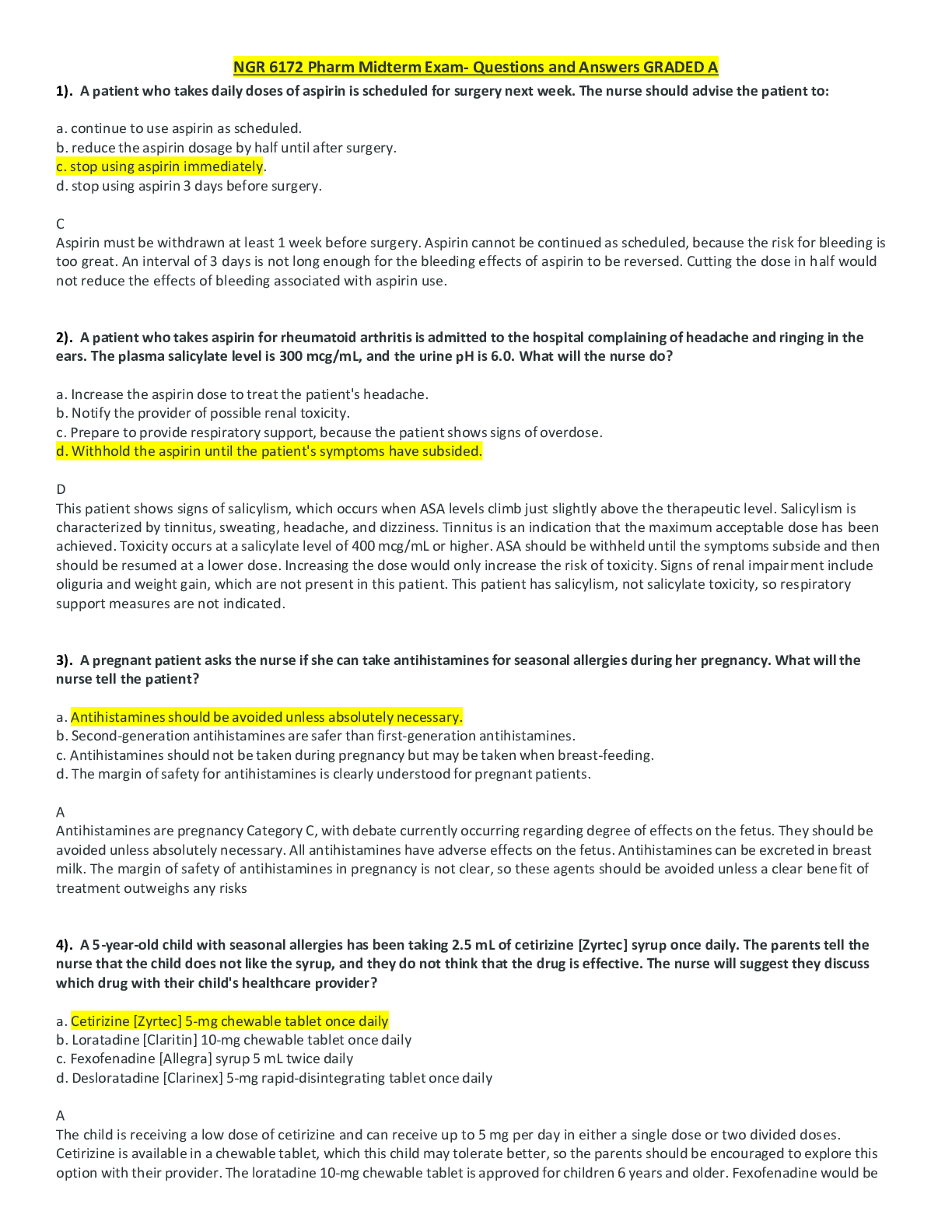
NGR 6172 Pharm Midterm Exam- Questions and Answers. Score 98%
NGR 6172 Pharm Midterm Exam- Questions and Answers GRADED A-1). A patient who takes daily doses of aspirin is scheduled for surgery next week. The nurse should advise the patient to: a. continue to...
By PROF , Uploaded: Feb 01, 2022
$11
Philosophy> EXAM > Intro to Ethics PHL 200 Unit 1 - Questions and Answers (All)

Intro to Ethics PHL 200 Unit 1 - Questions and Answers
PHL 200 Intro to Ethics Unit 1 Which of the following statements best describes the relationship between philosophy and science? Which of the following is a philosophical question? Which of the follow...
By Ajay25 , Uploaded: Jan 04, 2022
$9
Philosophy> EXAM > PHL 200 Introduction to Ethics Unit 4 - Questions and Answers (All)
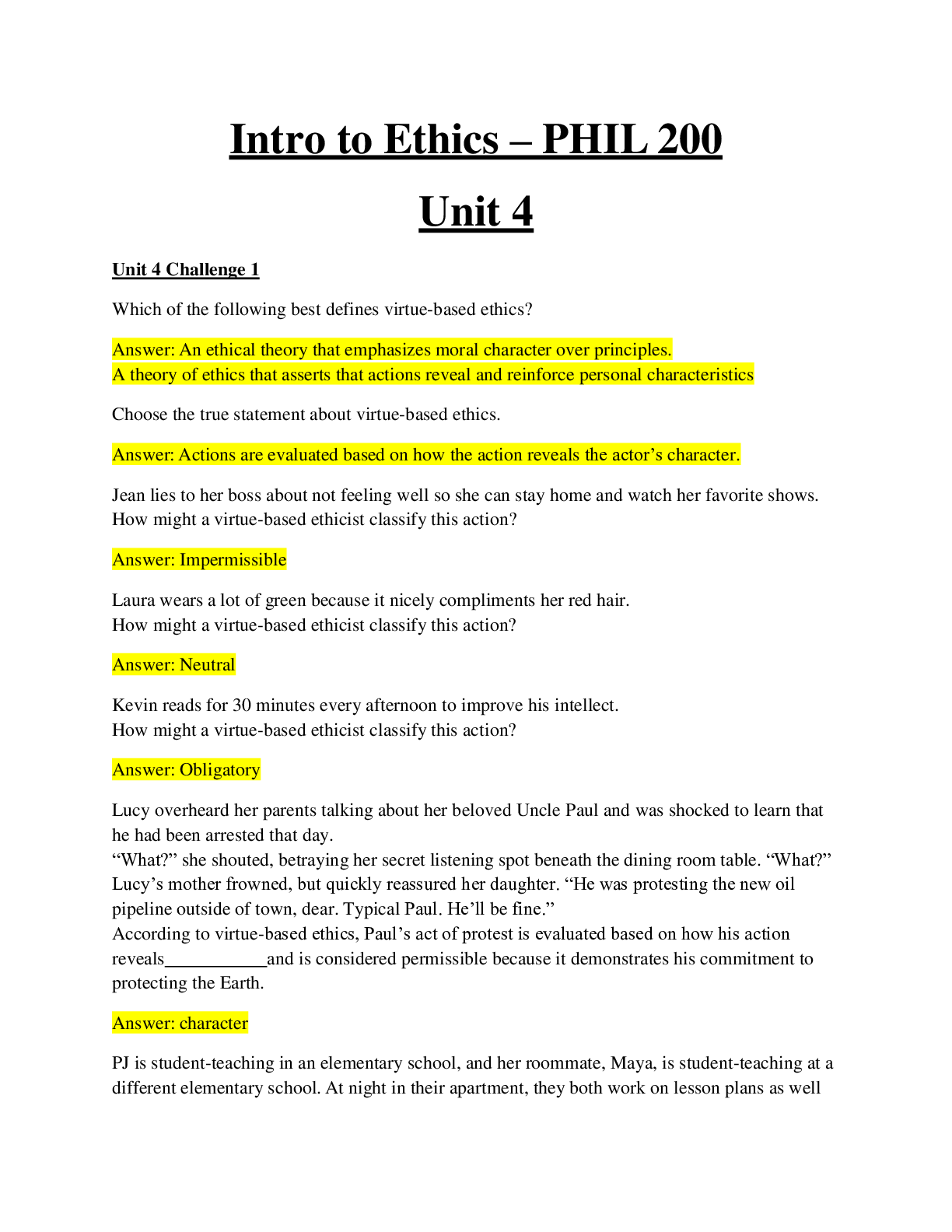
PHL 200 Introduction to Ethics Unit 4 - Questions and Answers
PHL 200 Intro to Ethics Unit 4 Which of the following best defines virtue-based ethics? Choose the true statement about virtue-based ethics. Jean lies to her boss about not feeling well so she can sta...
By Ajay25 , Uploaded: Jan 04, 2022
$10
Health Care> EXAM > NAPRx CNPR Exam WITH 160 Questions and Answers (All)
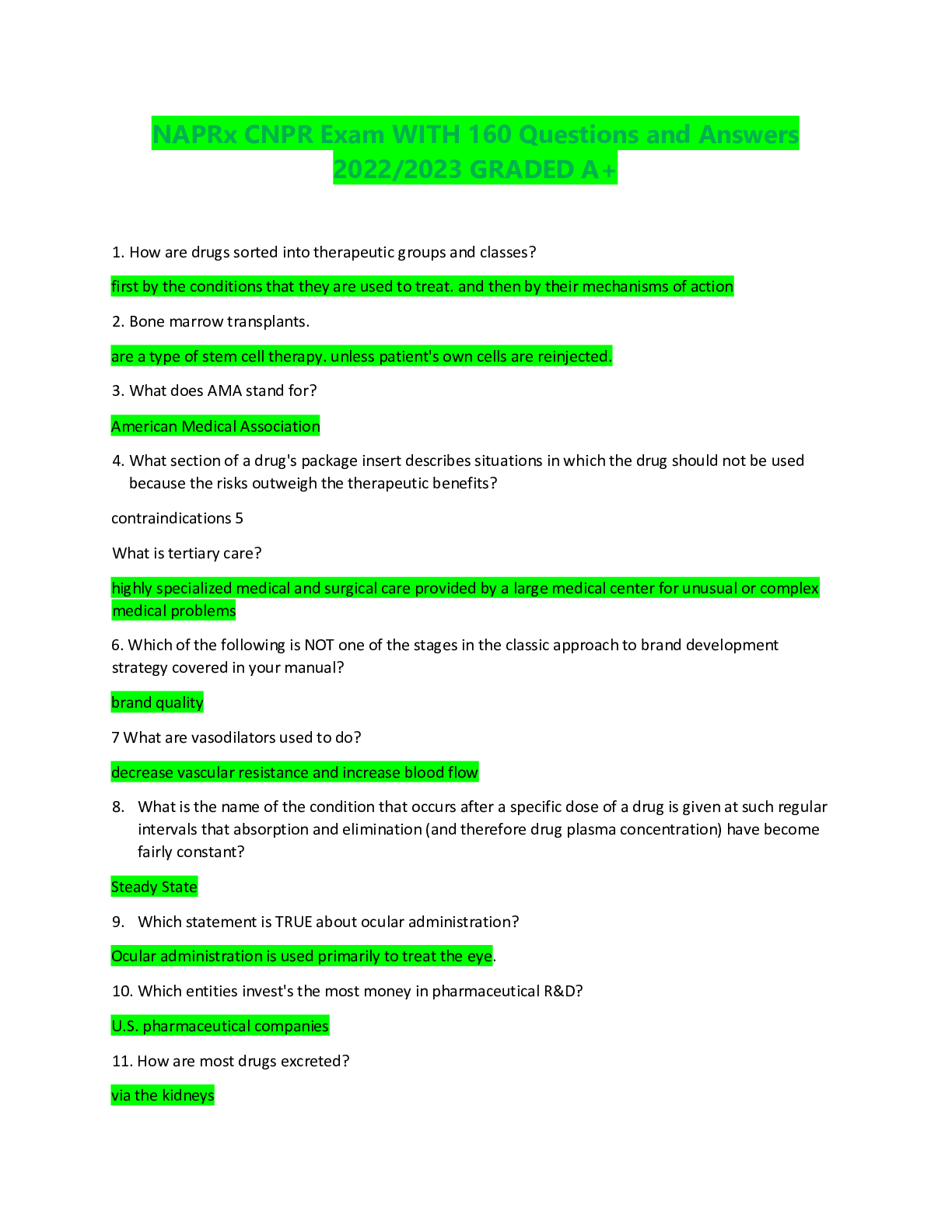
NAPRx CNPR Exam WITH 160 Questions and Answers
NAPRx CNPR Exam WITH 160 Questions and Answers 2022NAPRx CNPR Exam WITH 160 Questions and Answers 2022NAPRx CNPR Exam WITH 160 Questions and Answers 2022NAPRx CNPR Exam WITH 160 Questions and Answers...
By Otieno , Uploaded: Jan 25, 2023
$14
*NURSING> EXAM > HESI RN EXIT Exam V6 Full 160 Questions and Answers (All)
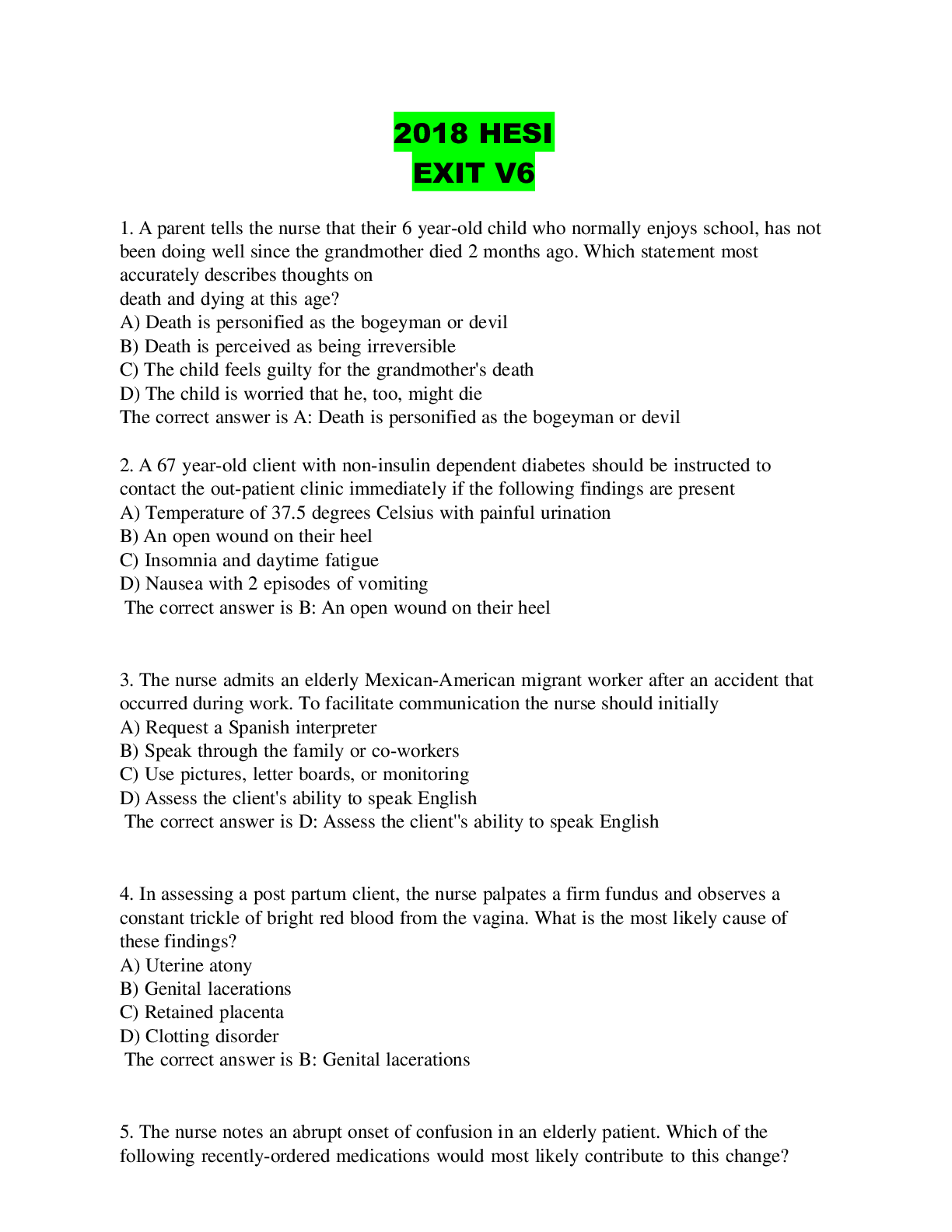
HESI RN EXIT Exam V6 Full 160 Questions and Answers
2021/2022 HESI RN EXIT EXAM V6 FULL 160 QUESTIONS AND ANSWERS./2021/2022 HESI RN EXIT EXAM V6 FULL 160 QUESTIONS AND ANSWERS.
By Grade A+ , Uploaded: May 16, 2022
$12
*NURSING> EXAM > Hesi Exit 5 - Contains 160 Questions And Answers (All)
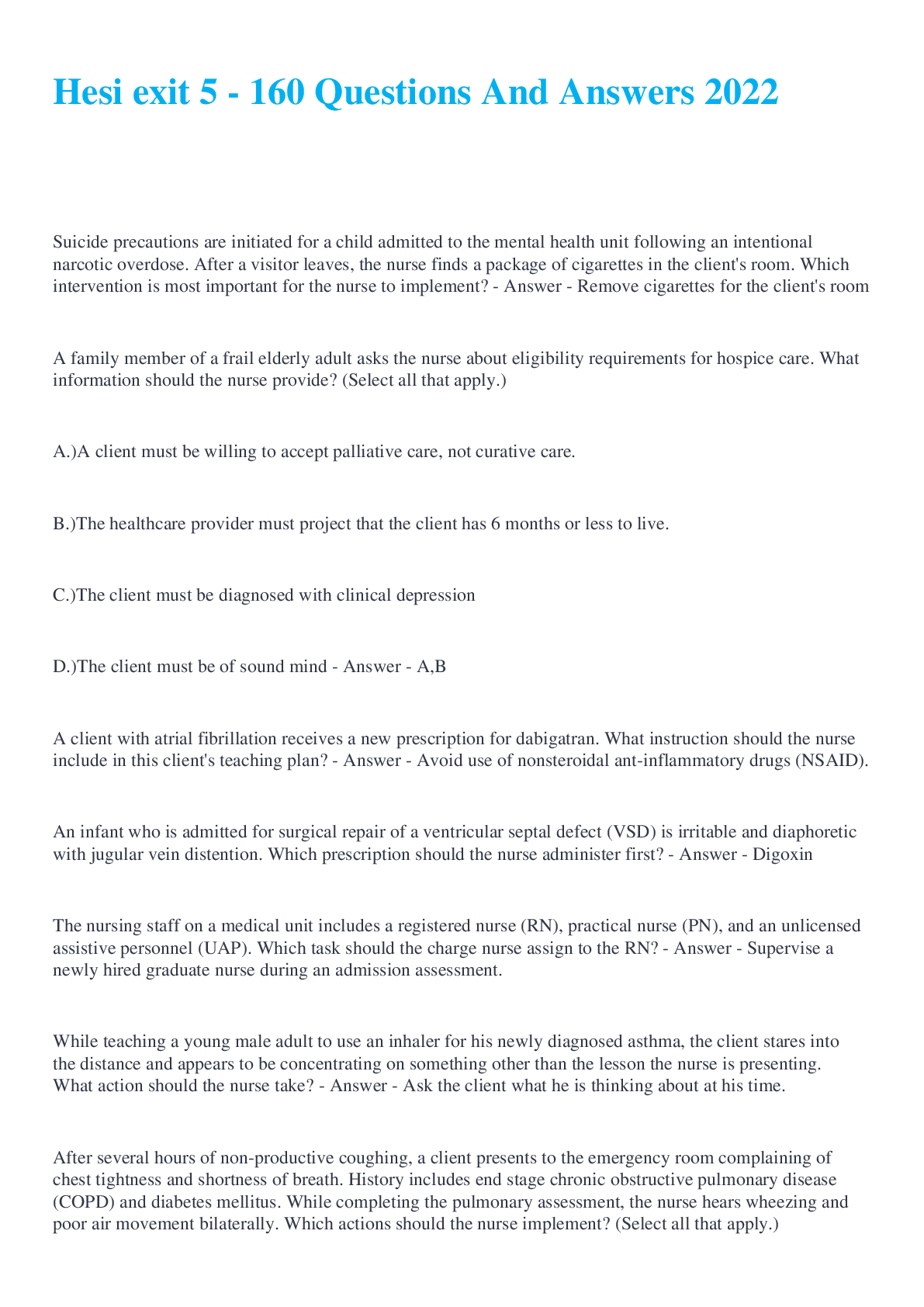
Hesi Exit 5 - Contains 160 Questions And Answers
Hesi exit 5 - 160 Questions And Answers 2022
By SUMMER , Uploaded: Aug 08, 2022
$14
*NURSING> EXAM > ATI RN Mental Health Online Practice B - 60 Questions and Answers (All)
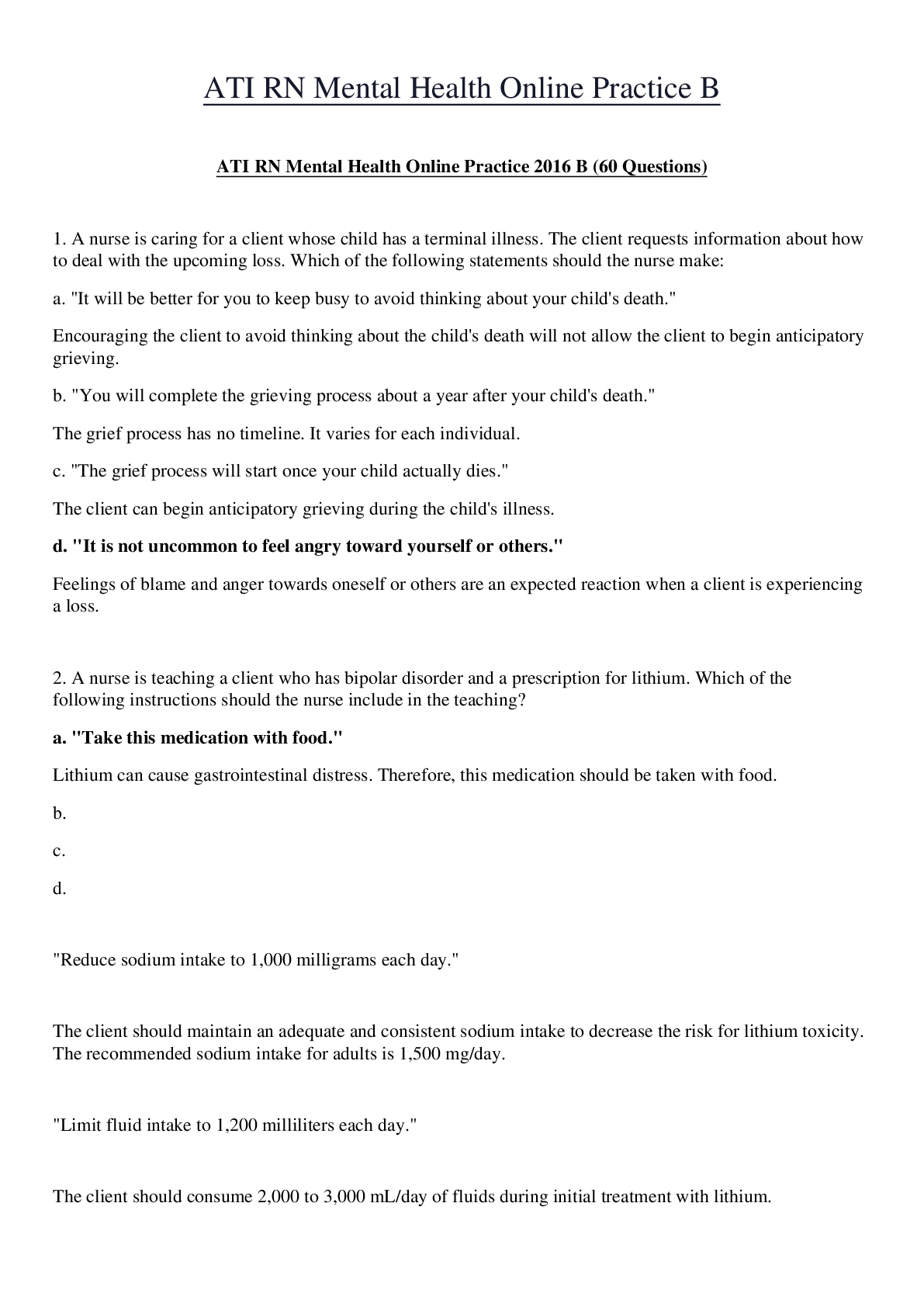
ATI RN Mental Health Online Practice B - 60 Questions and Answers
ATI RN Mental Health Online Practice B ATI RN Mental Health Online Practice 2016 B (60 Questions) 1. A nurse is caring for a client whose child has a terminal illness. The client requests inform...
By Martin Freeman , Uploaded: Jun 07, 2020
$14
Applied Science> EXAM > RBT Training Flashcards - RBT Training Modules | 281 Questions and Answers 100% Correct | COMPLETE | 42 Pages (All)
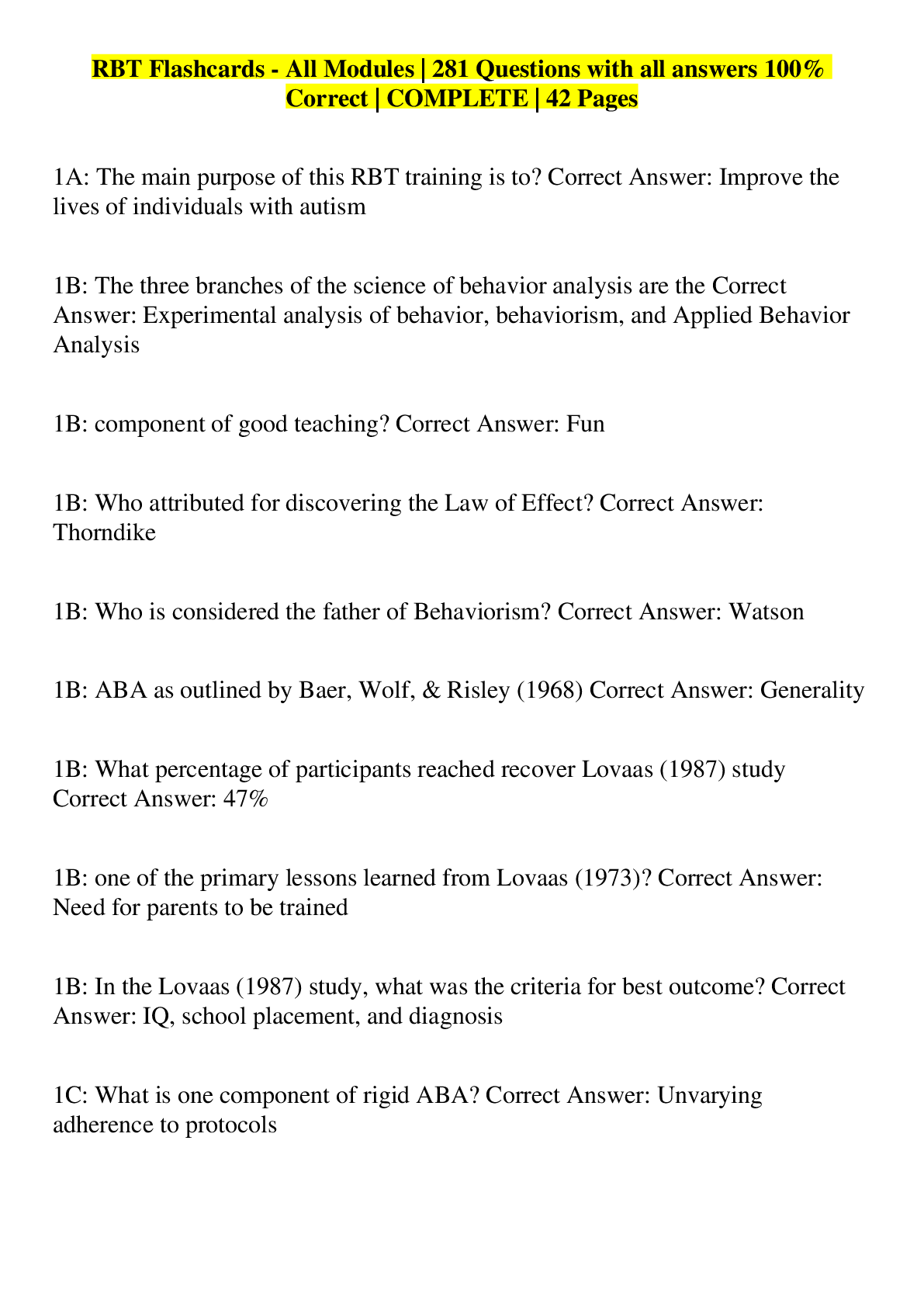
RBT Training Flashcards - RBT Training Modules | 281 Questions and Answers 100% Correct | COMPLETE | 42 Pages
1A: The main purpose of this RBT training is to? - ✔✔Improve the lives of individuals with autism 1B: The three branches of the science of behavior analysis are the - ✔✔Experimental analysis of beh...
By Tessa , Uploaded: Aug 08, 2022
$12
Food and Nutrition> EXAM > ServSafe Manager Exam. COMPLETE SOLUTION with 80 Questions And Answers. (All)
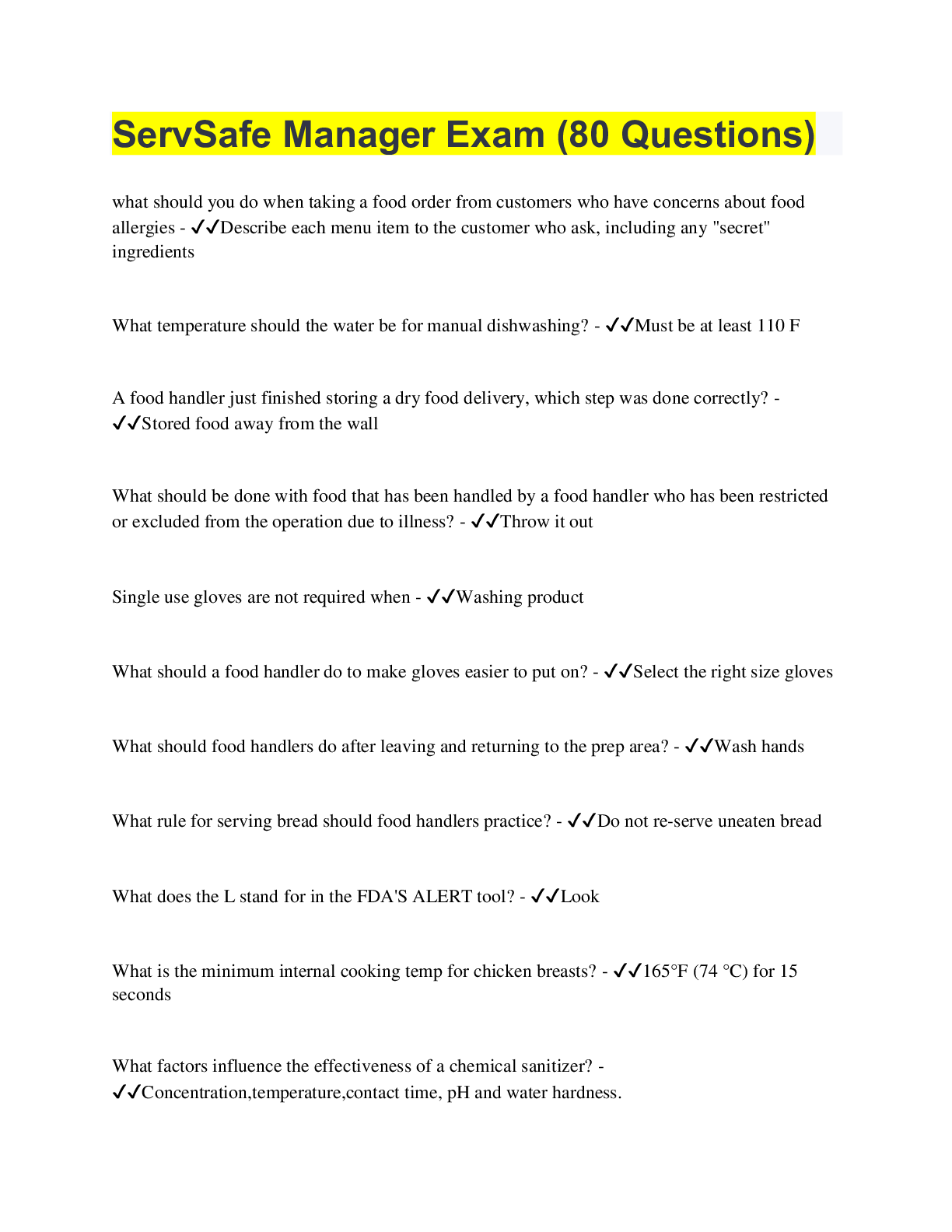
ServSafe Manager Exam. COMPLETE SOLUTION with 80 Questions And Answers.
what should you do when taking a food order from customers who have concerns about food allergies - ✔✔Describe each menu item to the customer who ask, including any "secret" ingredients What temper...
By Tessa , Uploaded: Jun 24, 2022
$11
*NURSING> EXAM > TNCC Final Exam Test 2022 Open Book. 50 Questions And Answers (All)
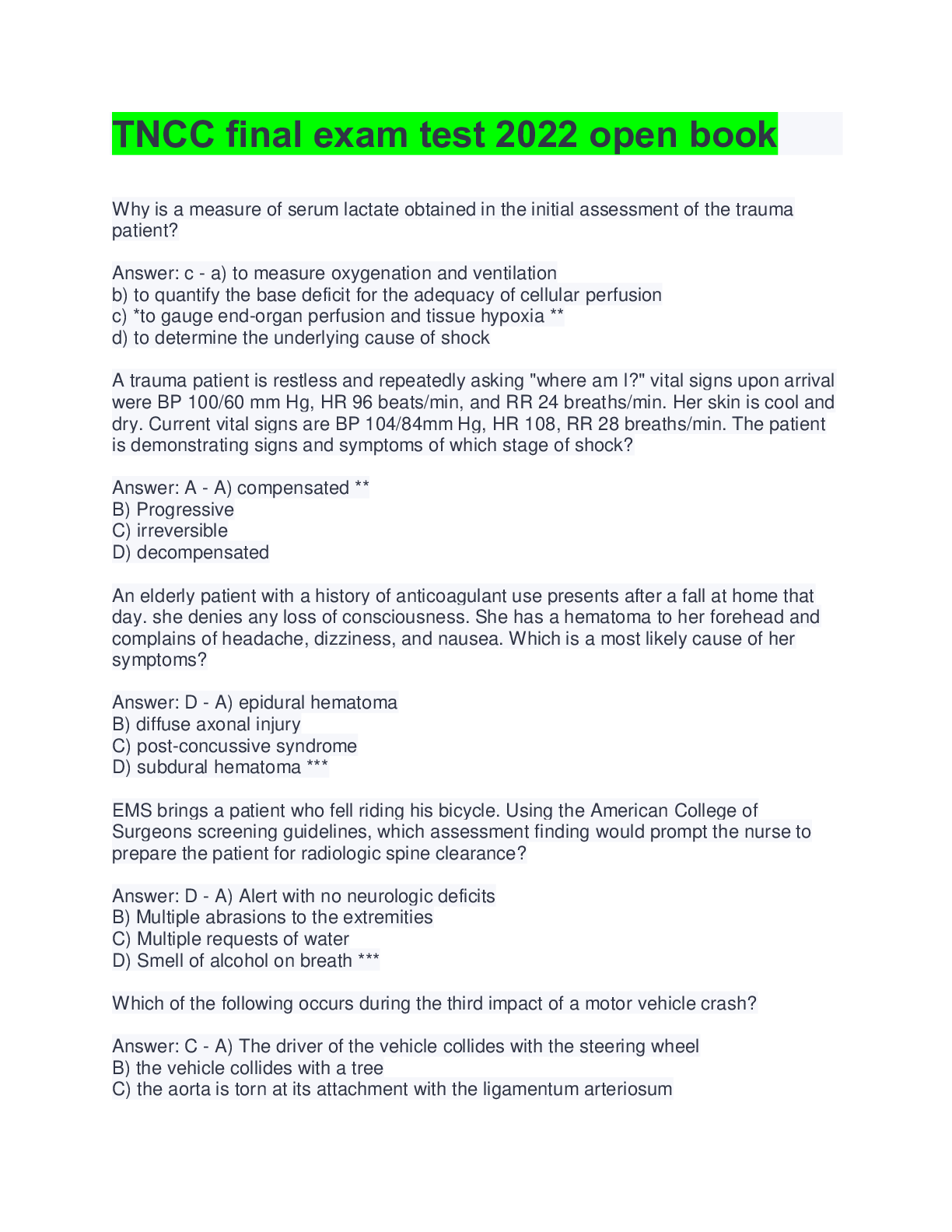
TNCC Final Exam Test 2022 Open Book. 50 Questions And Answers
TNCC final exam test 2022 open book Why is a measure of serum lactate obtained in the initial assessment of the trauma patient? a) to measure oxygenation and ventilation b) to quantify the base de...
By Axeldee , Uploaded: May 04, 2022
$12
Document information
Connected school, study & course
About the document
Uploaded On
Nov 05, 2022
Number of pages
22
Written in
Additional information
This document has been written for:
Uploaded
Nov 05, 2022
Downloads
0
Views
212







